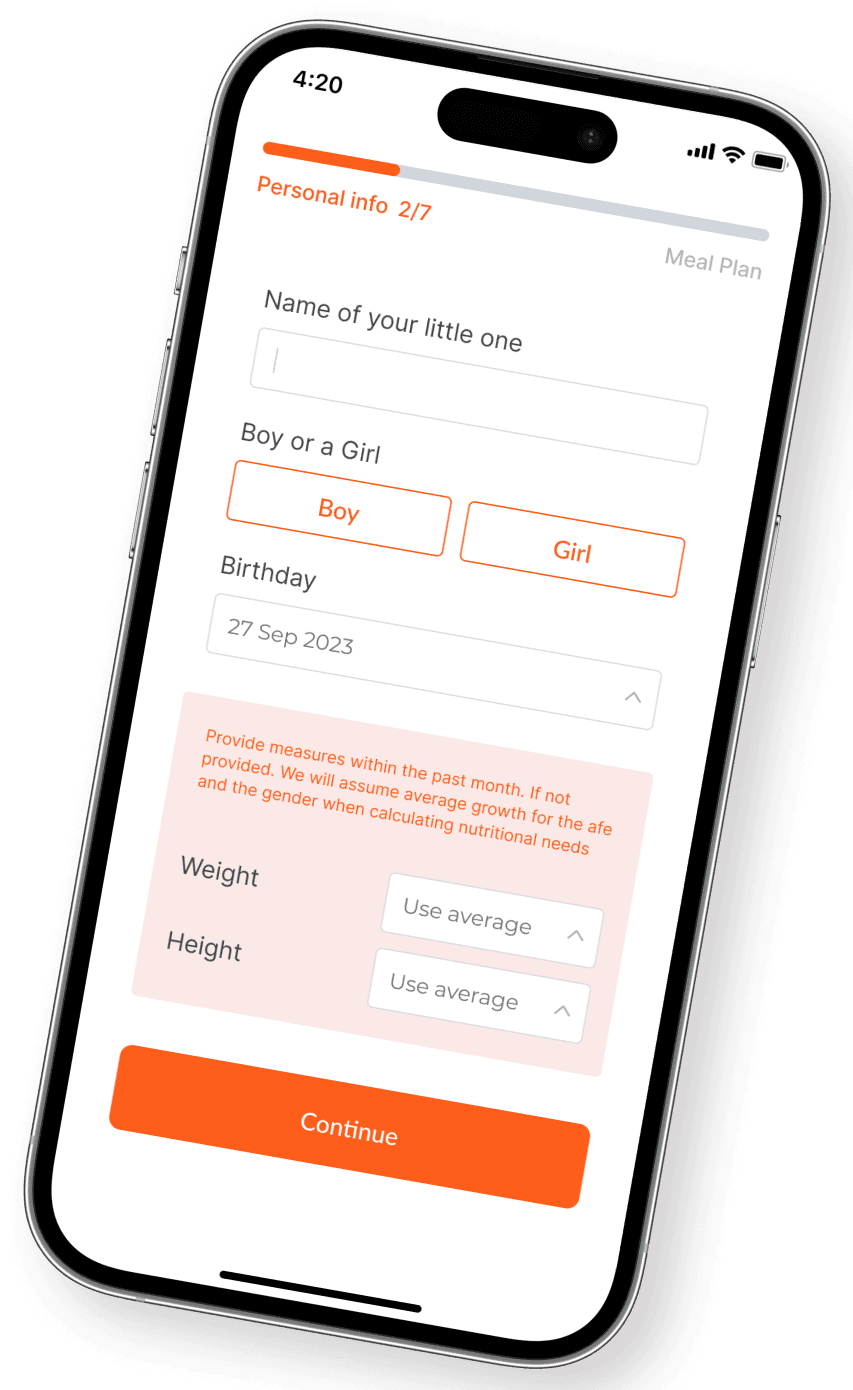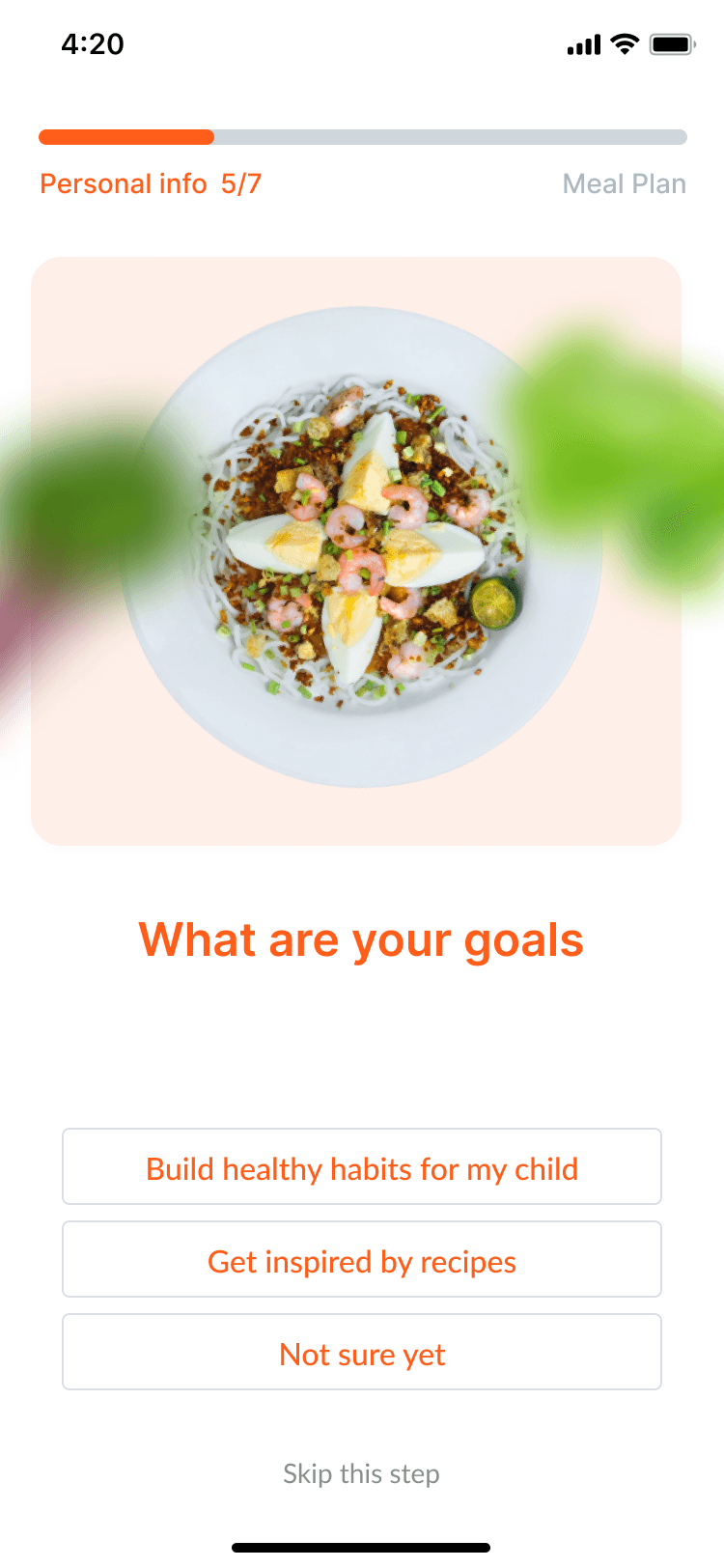How do we make the magic happen?
How is the nutrition calculated?
Our nutrition estimate is based on USDA food composition data. Each ingredient from recipe gets converted to nutrition data according to the USDA data, and the nutrition data is provided at very granular level, such as cooking method, frozen vs raw, and more. Although the actual nutritional value may vary by how it is actually prepared, we try our best to provide the best estimation.
Citation:
U.S. Department of Agriculture, Agricultural Research Service. FoodData Central, 2019. fdc.nal.usda.gov
How do we estimate your kid’s nutritional needs?
There is a standard nutrition DV for adults’ 2,000 kcal. But that’s barely true for babies and kids.
Every baby has a different need, and we agree with most of nutrition experts that we don’t want to count calories and nutritions for babies. On the other hand, we want to ensure to provide sufficient nutrition while not worrying about it too much.
Thankfully, USDA and USHHS have put together dietary guidelines with very detailed recommendation nutrient by nutrient. According to their guidelines, we estimate nutritional needs according to your baby’s growth. But please note that this is for informational purposes only, not to be substitutes for advice from medical professionals. If anything concerns you, we recommend you consulting with your pediatricians.
How do we score nutritional fit?
As explained above, we calculate nutrition values per serving for each recipe, along with your baby’s nutritional needs. Based on your consumption tracking data (if provided by you), we estimate which nutrients are needed by how much. Then, we search for recipes that have closest nutrition profile to your babies’ needs. So we request you to continue tracking eating using our app, so that we can recommend menus better!
About our meal plan recommendation:
Yes, our meal plan recommendation is completely individual and customized only for your baby! Depending on your baby’s stage, growth, past eating (what he/she eat in the past three days…), and your cooking preferences, we put the meal plan together.
We know that each one of you may have different priorities, and we gladly provide nine options for you to choose. We try our best to be transparent and explain each options that you can take in our app:
What is our magic approach?
We have A LOT of considerations packed in our magic.
First, we search our recipe repo by your babies’ stage.
Then, we have a few scoring mechanism:
Introduce new food one at a time.
Introduce a variety of flavors and textures.
Add allergen introduction frequent enough.
Provide a balanced palate of food groups and nutrition.
Don’t want to spend too much time in actual cooking.
Ensure to satisfy nutrition needs as described above.
All of the criteria gets scored to be in our magic.
All just for your baby.



Food introduction
According to American Academy of Pediatrics (AAP), it is recommended to introduce new food one at a time. And it is also recommended to provide a variety of texture and flavor.
Our goal is to suggest recipes that have only one or less number of new ingredients for your baby while providing a variety.
Our recommendation engine will curate the recipes for food introduction purpose while appropriate for your babies’ stage.
Allergen introduction
According to AAP and DGA, it is recommended to introduce allergenic foods as early as possible to prevent allergies. DGA explicitly calls out that for infants at high risk of peanut allergy, it is recommended to introduce peanut-containing foods at age 4-6 months.
If an infant has severe eczema, egg allergy, or both (conditions that increase the risk of peanut allergy), age-appropriate, peanut-containing foods should be introduced into the diet as early as age 4 to 6 months. This will reduce the risk of developing peanut allergy.” Our recommendation engine will ensure to include allergen-including menus at least every three days. For more information on the guideline, please check out DGA.
Citation:
U.S. Department of Agriculture and U.S. Department of Health and Human Services. Dietary Guidelines for Americans, 2020-2025. 9th Edition. December 2020. Available at DietaryGuidelines.gov.
Easy week
Very simple recipe search. We search recipes according to your babies’ stage AND search recipes with cooking time less than 30 minutes. And then we curate them based on your baby’s profile and past consumption in our tracking.
Use few ingredients
We search recipes according to your babies’ stage and pick the one that meets your baby’s nutritional needs the best.
Then, we curate the subsequent recipes based on the nutrition score AND the number of overlapping ingredients.
Family meal
Very simple recipe search. We search recipes according to your babies’ stage AND search recipes with the tag of Family Meal.
And then we curate them based on your baby’s profile and past consumption in our tracking.
BLW
Very simple recipe search. We search recipes according to your babies’ stage AND search recipes with the tag of BLW or finger foods. And then we curate them based on your baby’s profile and past consumption in our tracking.
Veggie / fruit
Very simple recipe search. We search recipes according to your babies’ stage AND search recipes with the tag of veggies / fruits.
And then we curate them based on your baby’s profile and past consumption in our tracking.
Protein
Very simple recipe search. We search recipes according to your babies’ stage AND search recipes with the tag of protein foods.
And then we curate them based on your baby’s profile and past consumption in our tracking.
Do you have more questions?
Read about our approach here. We try our best to be transparent and explain
what’s happening behind the scene on how we ensure baby nutrition.
If you have questions or comments, please contact us at
